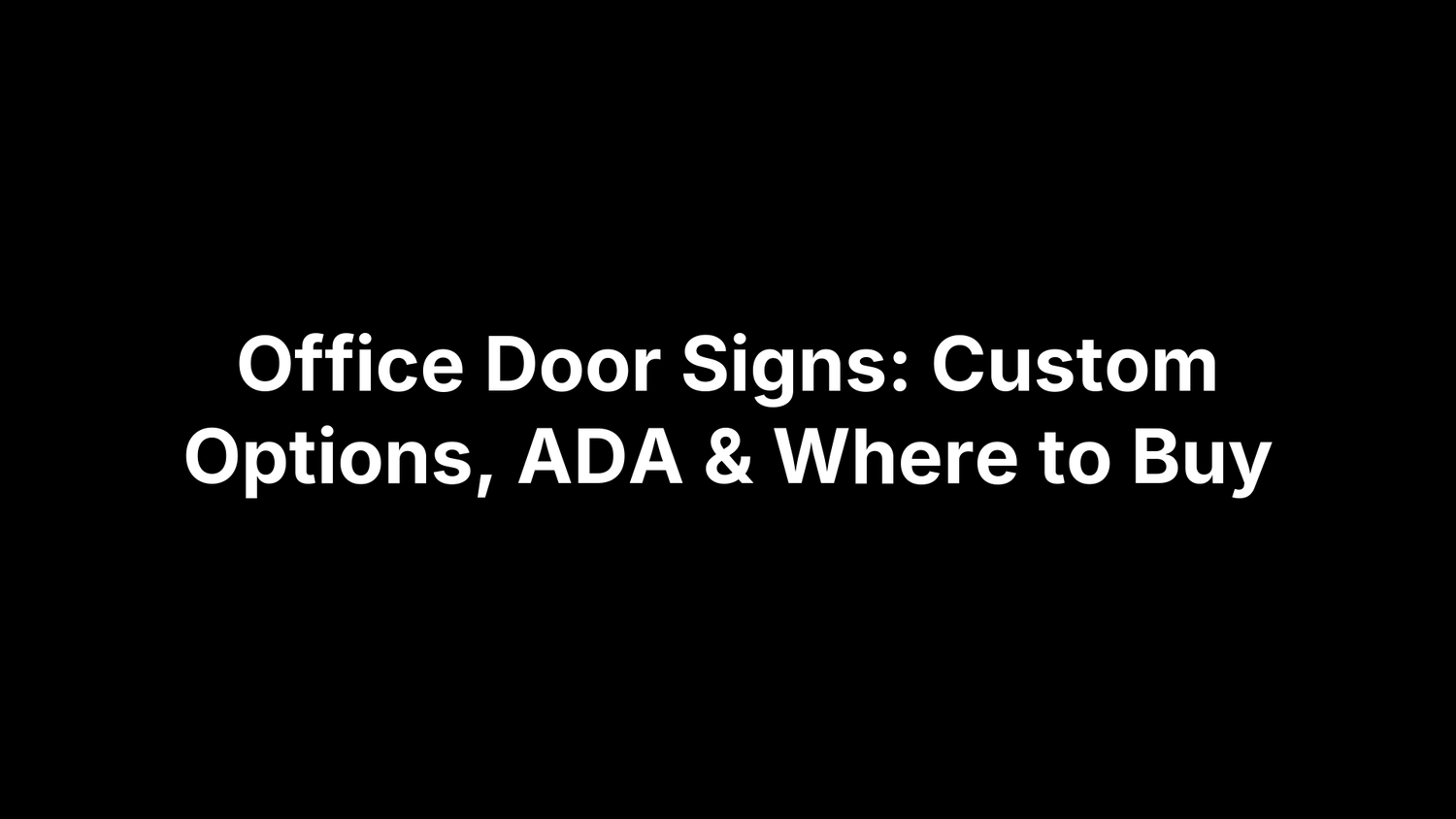Office Door Signs: Custom Options, ADA & Where to Buy
Office door signs are the labels and nameplates you mount on or near a doorway to identify a room, guide visitors, or share status and rules. Think “HR,” “Conference A,” “Restroom,” “Janitor,” “Occupied/Vacant,” or a name with title. They can be permanent or changeable, made from acrylic, metal, or engraved plastic, and sometimes applied as durable vinyl decals. When a sign identifies a permanent space (like a restroom or room number), ADA rules often require raised text and Braille so everyone can read it.
This guide shows you how to pick the right signs, get them compliant, and buy with confidence. You’ll learn why door signs matter for wayfinding, branding, and safety; which types fit which rooms; what ADA requirements apply (and what doesn’t); placement and mounting rules that inspectors check; readable, on-brand design tips; materials and durability options; smart customization like logos and changeable inserts; copy-and-paste wording; a buying checklist with costs and lead times; where to buy online or locally—and when decals are the better choice. Let’s get you set up the right way.
Why office door signs matter for navigation, branding, and safety
When someone steps off the elevator, office door signs do the quiet work of guiding them without a single question to reception. Clear, consistent room IDs and status indicators cut detours and interruptions, keeping meetings on time and operations smooth. Branded door signs for office suites carry your colors, fonts, and logo, reinforcing professionalism at every threshold. They also protect people and property: marking exits, restrooms, “Employees Only,” electrical or storage rooms, and occupied spaces, while ADA‑compliant tactile/Braille signage ensures equal access and reduces liability. Next, match your goals to the right sign type.
Types of office door signs and when to use each
Most workplaces need a mix of permanent identifiers and flexible pieces. Use this quick guide to match office door signs to each space, so visitors navigate faster and staff stay aligned. If you need a door sign office managers can update, choose options with inserts or sliders.
- Room IDs/Nameplates: Permanent spaces like “HR,” “Storage,” “Janitor.” Use tactile/Braille when they designate a fixed room.
- Room numbers: For navigation across suites and floors; keep numbering consistent. Typically tactile/Braille for permanent rooms.
- Suite/department with inserts: Changeable nameplates for teams and staff turnover.
- Sliding status signs: “In Use/Vacant” for conference rooms, huddle rooms, phone booths.
- Meeting frames with paper inserts: Post daily schedules or agendas.
- Restroom signs: Gendered or unisex with clear symbols; tactile/Braille for compliance.
- Exit and egress markers: Identify exit doors and stair access as part of safety wayfinding.
- Informational decals: “Employees Only,” “Deliveries,” “No Smoking”—stick directly on doors; not ADA tactile.
ADA requirements: what applies to door signs and what doesn’t
ADA rules kick in when office door signs identify a permanent room or space. For those plaques, use tactile (raised) characters in an ADA‑compliant sans serif, all uppercase, 0.625"–2" high, with Grade 2 Braille directly below the text. Mount on the latch side of the door, 48"–60" above the finished floor. Generally, don’t mount on the door; it’s allowed only on the push side when the door has an ADA‑compliant automatic closer and no hold‑open device. If you’re choosing door signs for office compliance, start here.
- Must be tactile/Braille (ADA): Permanent room IDs and numbers (e.g., Restroom, HR, Storage, Electrical), and any sign that designates a fixed space.
- Not required to be tactile/Braille: Informational decals and notices (hours, Employees Only, No Smoking, policies), meeting agendas/schedules in insert frames, temporary postings, and changeable employee name plates. These can go directly on the door or nearby and may use your preferred fonts and formats without raised text or Braille.
Placement and installation: getting location, height, and hardware right
Placement is compliance. For permanent room IDs, mount office door signs on the latch side of the opening, 48"–60" above the finished floor. Don’t mount on the door itself unless all three are true: it’s the push side, the door has an ADA‑compliant automatic closer, and there’s no hold‑open device. For informational notices and schedules that aren’t tactile/Braille, you may mount directly on the door or adjacent wall; keep a consistent baseline height and ensure the sign stays visible even when the door is propped open.
Use high‑bond adhesive on smooth walls or glass, screws on textured substrates, and magnetic options on metal doors. For “door sign office” needs: place tactile IDs next to the latch; non‑ADA decals can go on the door.
Design best practices for readable, on-brand signs
Great office door signs should be understood at a glance and feel like part of your brand. Start with clarity, then add consistent visual cues—type, color, and iconography—that repeat across the suite. For permanent ADA plaques, readability outranks decoration; for informational decals, you can be bolder while staying consistent with your visual system.
- Keep copy short: Aim for one to three words per line.
- Typeface/case: Use a clean sans serif; ADA tactile uses uppercase, mixed case boosts readability on non-ADA signs.
- Contrast: Dark text on light (or reverse) with brand colors as accents.
- Hierarchy & consistency: Largest for room name/number; lock a template for size, logo, and margins.
- Icons: Add clear pictograms (e.g., restrooms, stairs) to speed recognition.
- Spacing/alignment: Left align, keep generous margins, and leave space below for Braille on ADA plaques.
Materials, finishes, and durability options
Material and finish determine how your office door signs look, clean, and endure. Weigh foot traffic, cleaning chemicals, humidity, and sunlight, plus the surface (drywall, glass, metal). For a cohesive door sign office program, choose substrates you can repeat and maintain easily.
- Engraved two‑ply plastic: Cost‑effective, rigid, color‑stable; ideal for permanent room IDs.
- Acrylic (cast or laser‑cut): Crisp edges, dimensional look; mounts with tape or standoffs.
- Brushed/painted aluminum: Premium and tough; handles bumps and frequent cleaning.
- Laminated vinyl decals: Thin, affordable, high‑bond options; best for glass doors and policies.
- Changeable insert frames: Keep the holder, swap paper/plastic inserts for names or schedules.
Customization options: logos, changeable inserts, and variable data
Customization makes office door signs work harder—showing your brand, adapting to staffing changes, and keeping wayfinding consistent across floors. Start with a template so every door sign office managers order later matches the first: same type, colors, margins, and Braille placement where required. Then pick flexible components that let you update names, schedules, and room status without buying all-new plaques.
- Branding elements: Add your logo, brand colors, and approved typography to custom office door signs for a polished, consistent look.
- Changeable inserts: Use insert holders for suites, staff names, and meeting agendas; swap paper or plastic inserts in seconds.
- Sliding status panels: Choose “In Use/Vacant” sliders for conference rooms to prevent interruptions.
- Variable data sets: Batch‑produce signs with unique room numbers, names, departments, or sequences so every plaque is consistent yet specific.
- Decal companions: Pair permanent plaques with informational vinyl decals on the door for policies and hours (not ADA tactile).
Templates and wording ideas you can copy
Need copy fast? Start with these proven templates for office door signs. For ADA‑designating plaques keep wording short (1–3 words, uppercase) with Braille below; for policy decals and schedules you can use mixed case. Swap placeholders to fit your door sign office standards and stay consistent across floors and suites.
-
Permanent room ID (ADA):
HR·STORAGE·ELECTRICAL·JANITOR -
Room number (ADA):
201·201A·CONFERENCE A -
Suite/department + name insert:
Marketing — {Name}, {Title} -
Status sliders:
IN USE / VACANT·OCCUPIED / AVAILABLE -
Policy decals:
Employees Only·Deliveries·No Smoking·Please Knock -
Restroom (ADA):
RESTROOM·ALL‑GENDER RESTROOM
Buying checklist: how to choose a sign provider
Before you click “Buy,” vet the shop that will make your office door signs. You want a partner who can hit compliance, brand consistency, and deadlines—then support easy reorders as teams change. Use this quick checklist to choose a door sign office provider you can trust.
- ADA expertise: Tactile/Braille production and placement guidance (latch side, 48"–60").
- Materials that fit: Engraved plastic, acrylic, aluminum, or laminated decals.
- Customization: Logos, brand colors, inserts/sliders, variable data batches.
- Locked templates: Consistent layouts for future reorders across floors/suites.
- Mounting options: VHB, screws, magnets—with surface‑specific advice.
- Color proofing: PMS matching and samples on request.
- Timelines and support: Realistic lead times, clear shipping, and program help for reorders.
Typical costs, lead times, and quantity discounts
Budgeting for office door signs comes down to material, size, complexity, and volume. Engraved plastic and laminated decals are most economical; aluminum and thicker acrylic cost more. ADA tactile/Braille and color‑matching add steps and labor. Lead times hinge on proof approval and queue. For any door sign office rollout, batch orders lower per‑unit cost and keep finishes consistent.
- Economical options: Engraved two‑ply plastic plaques and laminated vinyl decals.
- Mid‑tier: Acrylic plaques and changeable insert frames; higher upfront, lower lifecycle.
- Premium: Brushed aluminum, custom shapes, standoffs, or sliders for status.
- Cost drivers: Size, mounting hardware, PMS match, sliders/inserts, Grade 2 Braille, variable data.
- Lead times: Stock templates are fastest; custom ADA and large runs take longer—ask about rush.
- Quantity discounts: Step pricing for sets (room numbers, nameplates); bundle project signage for savings.
Where to buy: online vendors, local shops, and when to use decals
Your best source depends on scope, compliance, and installation needs. For a multi-door rollout, prioritize consistency and ADA capability; for a single suite, speed and budget may win. Keep your “door sign office” standards handy so every order—wherever you buy—matches what’s already on the wall.
- Online sign vendors: Great for customizable office door signs with ADA tactile/Braille, templates, variable data (room numbers/names), proofs, and nationwide shipping with volume pricing.
- Marketplaces: Fast, budget-friendly for single nameplates or holders; verify specs carefully—most listings are not ADA tactile/Braille.
- Local sign shops: Ideal for site surveys, code/ADA placement guidance, color matching to building standards, and professional installation—especially in complex buildings.
- Use decals instead of plaques when: Posting policies/hours, labeling glass doors, managing frequent changes, or working under tight timelines/budgets. Pair a permanent tactile plaque at the latch side with a vinyl decal on the door for policies (decals are not ADA tactile).
Maintenance, updates, and building a signage program
Treat office door signs like assets, not decorations. Set a quarterly routine: wipe plaques and decals with mild soap and a soft cloth (no ammonia on acrylic), check VHB tape/screws, and replace scuffed decals. Keep a master sign schedule (room numbers, sizes, colors, ADA specs) and a reorder template so any door sign office request matches your standard. After renovations or renames, re-check latch-side placement and 48"–60" height for ADA.
- Maintenance cadence: Clean, inspect mounts, and swap damaged parts.
- Update workflow: Use variable-data templates and a single source for reorders.
- Governance: Assign an owner, budget for spares/inserts, and run an annual ADA check.
Key takeaways and next steps
Getting office door signs right comes down to clarity, compliance, and consistency. If a sign designates a permanent room, use tactile uppercase text with Grade 2 Braille and mount it latch‑side at 48"–60". Pair permanent plaques with decals for policies on the door. Lock a template, plan for variable data, and keep a master schedule so reorders, renovations, and audits are painless.
- Audit doors: Separate permanent IDs from informational/temporary; mark ADA vs. non‑ADA.
- Match types: Room IDs, numbers, inserts, sliders, and schedule holders as needed.
- Pick materials: Plaques (engraved plastic/acrylic/aluminum) plus laminated vinyl decals.
- Install right: Latch side, 48"–60"; on-door only with a compliant closer.
- Standardize & maintain: Templates, master sign list, quarterly cleaning, and stocked spares.
Need durable decals, labels, or guidance? Visit Safety Decals for customizable options and responsive support.


